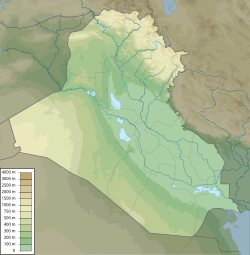Khalidiya Khanqah Mosque and Tekke
| Khalidiya Khanqah Mosque and Tekke | |
|---|---|
جامع وتكية خانقاه الخالدية | |
 The mosque, tekke, and marketplace in 2017 | |
| Religion | |
| Affiliation | Sunni Islam |
| Rite | Sufism |
| Ecclesiastical or organisational status | |
| Status | Active |
| Location | |
| Location | ڕزگارت, Kirkuk, Erbil, Erbil Governorate, Kurdistan Region |
| Country | Iraq |
Location of the religious complex in Iraq | |
| Geographic coordinates | 36°11′20″N 44°00′40″E / 36.1888883°N 44.0110142°E |
| Architecture | |
| Type | Islamic architecture |
| Founder | Mawlana Khalid al-Naqshbandi |
| General contractor | Mawlana Khalid al-Naqshbandi |
| Completed |
|
| Specifications | |
| Capacity | 500 worshippers |
| Interior area | 1,218 m2 (13,110 sq ft) |
| Minaret(s) | One |
| Minaret height | 27 m (89 ft) |
| Materials | Bricks; iron |
Building details | |
 | |
| General information | |
| Type | Religious building and marketplace |
| Renovated | 1961 |
| Renovating team | |
| Main contractor | Sheikh Muhammad Salih |
The Khalidiya Khanqah Mosque and Tekke (Arabic: جامع وتكية خانقاه الخالدية), also known as the Mzgawti Xanaqa (Kurdish: مزگەوتی خەنقە), is a religious complex comprising a Sufi mosque, tekke, library, and marketplace, located near the UNESCO World Heritage citadel in the city of Erbil, in the Erbil Governorate of the Kurdistan Region of Iraq. Completed in 1805 CE, the site was renovated in 1961.
History
[edit]The mosque and its adjoining Sufi lodge were founded in 1805 by the Kurdish Muslim scholar, Mullah Hidayatullah al-Arbili, on the orders of a Naqshbandi dervish named Mawlana Khalid al-Naqshbandi.[1][2][3][4] The local Naqshbandi dervishes of Erbil served as the management for the religious complex, amongst them Sheikh Muhammad Salih who supervised a complete rebuild and renovation in 1961.[1][2][3][5] A marketplace was developed around the mosque, as well as the Shar Park opposite it.[1][2][3] The surrounding citadel was added to the UNESCO World Heritage List in 2014.[6]
The surrounding neighbourhood of the mosque, dating back to at least 800 years during the reign of the Ayyubids over Kurdistan, has become known as the Khanqah neighbourhood due to its famed presence.[1][2][4]
Architecture
[edit]The religious complex is 1,218 square metres (13,110 sq ft) in area, built with bricks, and has capacity for approximately 500 worshippers.[1][2] The mosque minaret is 27 metres (89 ft) high with two accessible balconies, while the prayer hall is topped by a large dome with an internal frame structure made out of iron.[1][2] The library contains ancient manuscripts, religious books, and other material in Arabic, Turkish, and Persian languages.[2] Aside from the prayer hall, there are residential quarters for the Imam, the muezzin, and the mosque's workers.[1][2]
Gallery
[edit]-
Panoramic view of the Shar Park from the citadel, the mosque on the left
-
A similar view, in 2011
-
The mosque from Qalat street, below the citadel
See also
[edit]References
[edit]- ^ a b c d e f g Guide to Heritage and Archaeological Mosques by the Diwan al-Waqf al-Suniyi
- ^ a b c d e f g h "The oldest shop in Erbil will be protected by UNESCO and turned into a tourist area". Rudaw. Archived from the original on December 3, 2024. Retrieved December 20, 2024.
- ^ a b c خانقاه الخالدية.. معلم حضاري في قلب أربيل. قناة الغد (in Arabic). May 29, 2019. Retrieved December 20, 2024.
- ^ a b گەڕەكی خانەقای هەولێر 800 ساڵ تەمەنییەتی. www.knwe.org (in Kurdish). Retrieved December 20, 2024.
- ^ نەوەی لەقلەقەكەی هەولێر گەڕایەوە. www.radionawa.com (in Kurdish). Retrieved December 20, 2024.
- ^ "Erbil Citadel". World Heritage List. UNESCO. 2025. Retrieved July 4, 2025.




